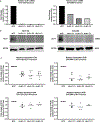Identification of a Locus Near ULK1 Associated With Progression-Free Survival in Ovarian Cancer
- PMID: 34162658
- PMCID: PMC8419101
- DOI: 10.1158/1055-9965.EPI-20-1817
Identification of a Locus Near ULK1 Associated With Progression-Free Survival in Ovarian Cancer
Abstract
Background: Many loci have been found to be associated with risk of epithelial ovarian cancer (EOC). However, although there is considerable variation in progression-free survival (PFS), no loci have been found to be associated with outcome at genome-wide levels of significance.
Methods: We carried out a genome-wide association study (GWAS) of PFS in 2,352 women with EOC who had undergone cytoreductive surgery and standard carboplatin/paclitaxel chemotherapy.
Results: We found seven SNPs at 12q24.33 associated with PFS (P < 5 × 10-8), the top SNP being rs10794418 (HR = 1.24; 95% CI, 1.15-1.34; P = 1.47 × 10-8). High expression of a nearby gene, ULK1, is associated with shorter PFS in EOC, and with poor prognosis in other cancers. SNP rs10794418 is also associated with expression of ULK1 in ovarian tumors, with the allele associated with shorter PFS being associated with higher expression, and chromatin interactions were detected between the ULK1 promoter and associated SNPs in serous and endometrioid EOC cell lines. ULK1 knockout ovarian cancer cell lines showed significantly increased sensitivity to carboplatin in vitro.
Conclusions: The locus at 12q24.33 represents one of the first genome-wide significant loci for survival for any cancer. ULK1 is a plausible candidate for the target of this association.
Impact: This finding provides insight into genetic markers associated with EOC outcome and potential treatment options.See related commentary by Peres and Monteiro, p. 1604.
©2021 American Association for Cancer Research.
Conflict of interest statement
Conflicts of interest:
There are no conflicts of interest to disclose.
Figures





Comment in
-
Scratching Below the Ovarian Cancer GWAS Surface.Cancer Epidemiol Biomarkers Prev. 2021 Sep;30(9):1604-1606. doi: 10.1158/1055-9965.EPI-21-0568. Cancer Epidemiol Biomarkers Prev. 2021. PMID: 34475121
References
-
- Ferlay J. 2013 13 November. GLOBOCAN 2012 v1.0, Cancer Incidence and Mortality Wordwide: IARC CancerBase No. 11. <http://globocan.iarc.fr>. Accessed2013 13 November.
-
- Markman M. Pharmaceutical Management of Ovarian Cancer: Current Status. Drugs 2019;79:1231–9 - PubMed
-
- Marchetti C, Pisano C, Facchini G, Bruni GS, Magazzino FP, Losito S, et al.First-line treatment of advanced ovarian cancer: current research and perspectives. Expert Rev Anticancer Ther 2010;10:47–60 - PubMed
-
- Moore KN, Tritchler D, Kaufman KM, Lankes H, Quinn MCJ, Van Le L, et al.Genome-wide association study evaluating single-nucleotide polymorphisms and outcomes in patients with advanced stage serous ovarian or primary peritoneal cancer: An NRG Oncology/Gynecologic Oncology Group study. Gynecol Oncol 2017;147:396–401 - PMC - PubMed
Publication types
MeSH terms
Substances
Grants and funding
- C536/A6689/CRUK_/Cancer Research UK/United Kingdom
- R01 CA058598/CA/NCI NIH HHS/United States
- C12292/A11174/CRUK_/Cancer Research UK/United Kingdom
- P50 CA105009/CA/NCI NIH HHS/United States
- C1287/A 10710/CRUK_/Cancer Research UK/United Kingdom
- U19 CA148537/CA/NCI NIH HHS/United States
- R01 CA076016/CA/NCI NIH HHS/United States
- R01 CA248288/CA/NCI NIH HHS/United States
- U19 CA148112/CA/NCI NIH HHS/United States
- R01 CA149429/CA/NCI NIH HHS/United States
- U19 CA148065/CA/NCI NIH HHS/United States
- C1281/A12014/CRUK_/Cancer Research UK/United Kingdom
- UL1 TR001881/TR/NCATS NIH HHS/United States
- R01 CA126841/CA/NCI NIH HHS/United States
- 16561/CRUK_/Cancer Research UK/United Kingdom
- C536/A13086/CRUK_/Cancer Research UK/United Kingdom
- P50 CA159981/CA/NCI NIH HHS/United States
- M01 RR000056/RR/NCRR NIH HHS/United States
- R01 CA095023/CA/NCI NIH HHS/United States
- C5047/A10692/CRUK_/Cancer Research UK/United Kingdom
- UL1 TR000124/TR/NCATS NIH HHS/United States
- K07 CA080668/CA/NCI NIH HHS/United States
- C5047/A8384/CRUK_/Cancer Research UK/United Kingdom
- P30 CA008748/CA/NCI NIH HHS/United States
- R01 CA128978/CA/NCI NIH HHS/United States
- R01 CA054419/CA/NCI NIH HHS/United States
- R01 CA122443/CA/NCI NIH HHS/United States
- P30 CA015083/CA/NCI NIH HHS/United States
- C5047/A15007/CRUK_/Cancer Research UK/United Kingdom
- C1287/A10118/CRUK_/Cancer Research UK/United Kingdom
- P50 CA136393/CA/NCI NIH HHS/United States

